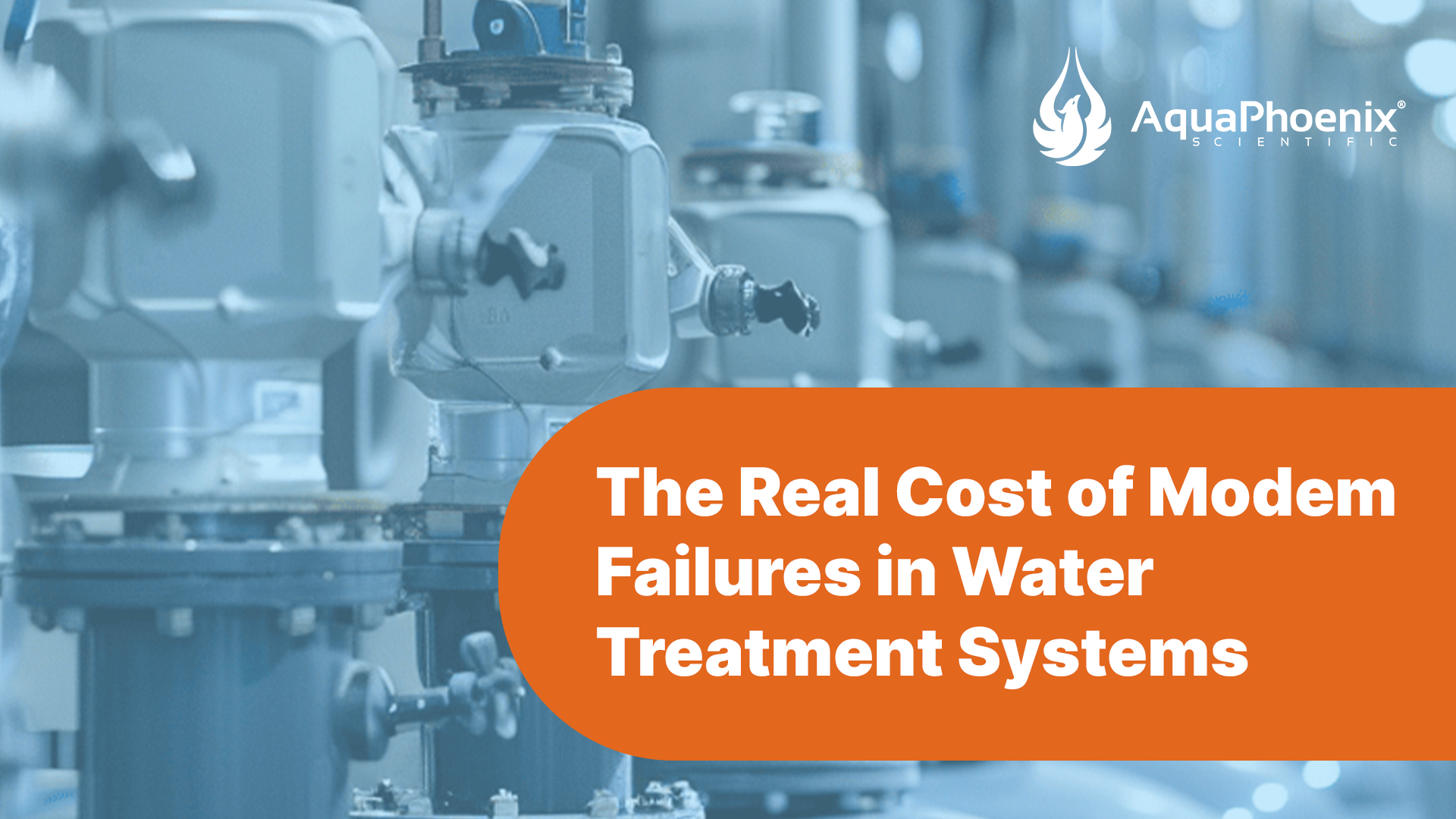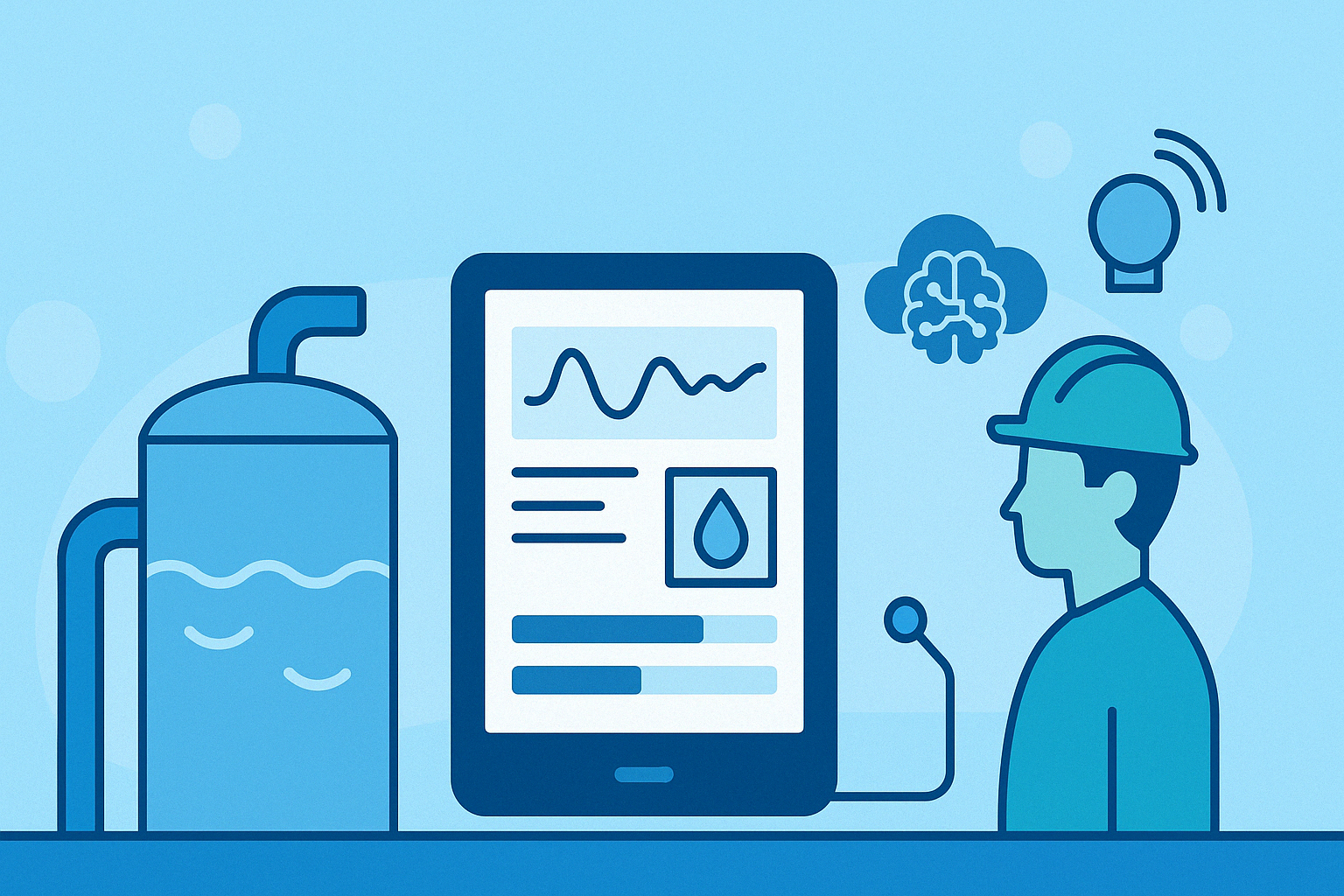
Behind every efficient, automated industrial water treatment system lies an unsung hero: the modem. These small devices quietly relay critical data from remote tanks, sensors, and PLCs to centralized dashboards, helping operators monitor water quality, detect anomalies, and maintain compliance. But while the importance of network connectivity is universally understood, the modems that enable it are often treated as “set it and forget it” hardware. That approach alone is a critical modem management mistake.
Inconsistent connectivity, outdated firmware, or simply forgotten devices across multiple sites can create unseen vulnerabilities. These issues don’t just lead to modem issues; they invite compliance failures, security breaches, and unexpected operational costs. It’s time to rethink how modem fleets are managed.
Let’s examine five critical mistakes many operations make and how smarter modem management can make all the difference.
Mistake #1: No Visibility Into Remote Modems Across Treatment Sites
Large-scale industrial water treatment often involves geographically dispersed infrastructure—pumping stations, lift stations, treatment plants, and reservoirs. Each site might rely on one or several modems to transmit telemetry and control data. But once deployed, many of these modems fall off the radar.
Without centralized oversight, network connectivity issues at one remote site may go unnoticed for days or even weeks. The result? Incomplete data, undetected faults, or regulatory violations due to missing logs.
The solution lies in implementing a unified dashboard—a Single Pane of Glass—that provides real-time visibility into every modem across your network. A centralized system should show connection status, signal strength, data flow rates, and even alert history. With that insight, teams can proactively address problems with modems before they disrupt compliance or safety.
Mistake #2: Delaying Firmware Updates in Critical Infrastructure
Firmware updates often feel like a low priority until something goes wrong. In reality, outdated firmware in water treatment systems is a serious liability. It exposes critical infrastructure to cybersecurity risks, software bugs, and data transmission failures.
In a regulated environment, unpatched devices can mean falling out of compliance. Worse, a compromised modem could serve as a backdoor into your SCADA network.
Modern modem management solutions automate firmware updates across entire device fleets. These systems schedule updates during low-traffic hours, ensuring minimal disruption while keeping devices secure and standards-compliant. Operators don’t have to wonder whether a modem’s running on obsolete software. The system handles it for them.
Mistake #3: Waiting for Failures Instead of Monitoring Proactively
Water treatment can’t afford lag time. A pump fault or data gap could lead to environmental violations or public health concerns. Yet many operations still rely on reactive modem monitoring, only addressing issues when a device stops working entirely.
This is where proactive diagnostics make a massive impact. Heartbeat alarms, for instance, notify you the moment a modem drops offline. Advanced platforms also offer continuous signal diagnostics, battery level monitoring (for solar or battery-powered modems), and intelligent failure prediction.
The shift from reactive to proactive monitoring doesn’t just reduce downtime. It builds resilience across your network and prevents modem issues from snowballing into full-blown system outages.
Mistake #4: Overlooking Data Plan Management, Leading to Budget Surprises
Every modem in a water treatment system contributes to your total telemetry traffic, sending flow readings, system alerts, remote commands, and configuration changes. But that data can spike unexpectedly. A software glitch, stuck sensor, or runaway logging script can flood your system with excess usage overnight.
Without proper oversight, this leads to painful overage fees and underused capacity, especially when each modem operates on an individual plan. It’s inconvenient, costly, and unsustainable.
Proactive modem management platforms prevent this by pooling data plans across devices. Shared pools mean high-usage modems are automatically balanced against those using less, reducing waste and avoiding surprise bills. Some systems also detect rogue devices or usage anomalies, alerting you the moment traffic exceeds expected baselines.
The result is a controlled, transparent data ecosystem that supports budgeting accuracy and protects operational costs.
Mistake #5: Weak Security Practices in Critical Water Systems
It’s easy to assume that if your modem is transmitting data, it must be secure. Unfortunately, that’s rarely the case. Too many water systems still rely on modems that use default passwords, lack encryption, or operate without a secure VPN tunnel. In today’s cyber landscape, that’s an open invitation for intrusion.
The risk isn’t theoretical. Industrial systems are increasingly targeted by cyberattacks. A compromised modem can provide access not only to remote telemetry but to entire control systems, jeopardizing public safety and exposing organizations to legal and regulatory consequences.
This is where security-focused solutions like Flight come in. Designed for industrial water treatment, Flight enforces VPN connections, password policies, and encrypted data transmission by default. Its zero-trust model ensures devices authenticate before connecting, and every transaction is logged and auditable.
Strong security isn’t optional anymore. It’s a foundational component of operational integrity.
From Passive to Proactive: Rethinking Connectivity Management
Modems may not be flashy, but they’re the connective tissue of today’s smart water infrastructure. Treating them as passive hardware—deploy and ignore—invites silent failures, budget oversights, and security risks. Network connectivity issues often trace back to preventable gaps in how modems are monitored, updated, and secured.
Here’s a quick recap of the five modem mistakes to avoid:
- No visibility into remote modem status across sites.
- Delayed firmware updates in mission-critical infrastructure.
- Reactive maintenance instead of continuous monitoring.
- Unmanaged data usage, leading to overages and waste.
- Poor security hygiene that exposes sensitive water systems.
Each of these is avoidable with the right tools and approach.
Protect Your Infrastructure With Flight
AquaPhoenix created Flight to address exactly these challenges. This modem fleet management platform was built with industrial water treatment in mind, offering real-time visibility, automated updates, pooled data plan oversight, and enterprise-grade security protocols.
With Flight, you don’t just prevent modem issues—you take control of your communications backbone and safeguard the data driving your compliance, efficiency, and uptime.
Don’t wait for network connectivity issues to expose vulnerabilities in your operation. Reach out to AquaPhoenix to learn how Flight helps you monitor, manage, and secure every modem in your system from a single, intuitive platform.
How recent changes to tariff regulations may impact product and project purchases from AquaPhoenix Scientific.
Several of our partners have announced price increases due to the recently imposed tariff regulations. This list is updated as we receive new information. Please check back often.
NOTE: The prices for the vendors listed below will increase as shown. Also, any AquaPhoenix manufactured items that contain the distributed products will increase as well.
| Implemented | |||
| Company | Effective Date | % Increase | Products |
| Advantage Controls | Immediately | 2.5% | All products |
| Ahlstrom | Immediately | 5% | All products |
| Belimo | Immediately | 7.7% | All products |
| Carlon | Immediately | 15% | All products |
| Extech Products | Immediately | 5% | All products |
| Hach | Immediately | 3% | All products |
| IFM Efector, Inc. | Immediately | 8% | All products |
| LaMotte | Immediately | 3.5% | All products |
| LMI Enterprises | Immediately | 3% | All products |
| Lovibond/ Tintometer | Immediately | 3% | All products |
| Lutz Pumps | Immediately | 4% | All products |
| Neogen | Immediately | 4% | All products |
| Ohaus | Immediately | 10 – 20% | All products, percent varies by item |
| ProMinent USA | Immediately | 2-7% | Select products. Percent varies by item. |
| 7% | Beta | ||
| 4% | DFXa/DFYa | ||
| 2% | Gamma X/XL | ||
| 2% | Sigma | ||
| 3% | Process Pumps | ||
| 5% | All Accessories | ||
| 5% | All Sensors | ||
| 5% | All Controllers | ||
| 7% | All Spare Parts | ||
| 3% | All Polymer systems except ProMix H | ||
| 5% | All Disinfection Equipment | ||
| 3% | All other not listed | ||
| 7-10% | All products, percent varies by item | ||
| Pulsafeeder | Immediately | 1.5 – 2.5% | All products, percent varies by item |
| Pyxis | Immediately | 10% | Equipment & accessories |
| 5% | PTSA tracer products | ||
| Seametrics | Immediately | 4.5 – 26% | All products, percent varies by item |
| Sensorex | Immediately | 6.1 – 7.1% | All products |
| Thermo Fisher Orion Products | Immediately | 4-8% | All products, percent varies by item |
| Walchem | Immediately | 6.5% | WFP Paddlewheel Flowmeters & accessories |
| 100% | WFM Flowmeters & spare parts | ||
| 7.3% | Controllers, Associated Parts, Accessories | ||
| 3.5% | Metering Pumps, Iwaki Pumps, Associated Parts, Accessories | ||
| 7.5% | Iwaki Air, Iwaki Sanwa Pumps | ||
| Watson Marlow | Immediately | 4% | All products |
| VeeGee Scientific | Immediately | 10% | All products |
| Upcoming |
| Company | Effective Date | % Increase | Products |
We are working to manage these increases through strategic sourcing and process improvements that allow us to minimize the impact on your business. Please know that maintaining cost stability remains a priority.
If you need assistance, please contact us at 866-632-1291 or email [email protected].
Sincerely,
Frank Lecrone
President and CEO

The Cost of Unmanaged Modems in Water Treatment Operations
Key Takeaways:
- Unmanaged modems create hidden costs in water treatment systems, including data overage fees, security risks, and operational inefficiencies that increase overall water treatment costs.
- Telemetry pipeline disruptions from modem failures can lead to missed alerts, delayed responses, and compliance risks, especially during critical system loads.
- DIY modem management adds complexity and strain on internal teams, often resulting in more truck rolls, downtime, and inflated water treatment system costs.
- A managed modem manager service like Flight improves visibility, security, and reporting, helping facilities reduce inefficiencies and maintain compliant, connected operations.
Every modern water treatment facility relies on constant connectivity to keep systems optimized and compliant. From monitoring chemical dosing to triggering emergency alerts, the flow of real-time data is the backbone of smart water infrastructure. Yet for many operations, the humble modem — a critical link in the telemetry pipeline — goes unnoticed until something breaks.
That’s when costs start to pile up.
While the upfront price of a modem may seem minor compared to larger system components, unmanaged modem fleets often lead to hidden expenses that quietly drain resources. From unexpected data charges to preventable downtime, failing to actively manage connectivity infrastructure introduces operational inefficiencies that quickly erode margins.
Unseen Financial Risks Behind Unmanaged Modems
- Data Overage Charges. Without oversight, telemetry devices can flood networks with excessive data — especially when stuck in error loops or running outdated software. When each modem operates on an individual plan, it’s easy to surpass limits, leading to surprise bills. These overages inflate water treatment cost calculations and distort annual budgets.
- Security Vulnerabilities. Outdated firmware, default credentials, or improperly managed remote access settings can leave telemetry modems vulnerable to cyberattacks. A single breach could compromise sensitive system data or enable malicious control of critical operations. The resulting fallout — from emergency response costs to long-term reputational damage — adds yet another hidden line item to the true cost of unmanaged infrastructure.
- Increased Field Dispatches. Modem failures often trigger costly technician visits. When connectivity drops without warning and there’s no remote insight, the default response becomes manual inspection. These service calls, commonly known as “truck rolls,” add labor hours, delay response times, and interrupt workflows.
- Downtime and Delayed Alerts. In water treatment systems, real-time visibility isn’t a luxury — it’s a necessity. Lost modem connections mean critical alerts may never reach control centers. A missed notification about a pressure drop or dosing imbalance can halt production or risk environmental compliance, adding both financial and reputational costs.
Compliance and Process Integrity at Risk
Unmanaged modems also pose a less visible, but just as costly, risk to regulatory compliance. Gaps in water quality reporting or system logs can trigger audits or penalties, especially in industries bound by EPA or state water board standards. Whether it’s a wastewater discharge or potable water application, continuous data flow ensures every decision is backed by traceable records.
Worse still, these lapses often happen during peak operational loads — when consistent connectivity matters most.
Why DIY Doesn’t Work in Industrial Settings
It’s tempting to manage modems in-house, especially when budgets are tight. But most water treatment operations already stretch their IT and field service teams thin. Relying on ad hoc methods or disconnected tools only increases complexity. The supposed savings are quickly erased by emergency maintenance, compliance headaches, and growing water treatment system costs.
A Smarter Approach: Managed Modem Services
A managed modem service like Flight transforms connectivity from a cost center into a control point. Designed specifically for industrial environments, Flight provides centralized visibility, pooled data plan management, and proactive diagnostics. This ensures no device is forgotten, no alert is missed, and no modem operates outside of expected parameters.
By integrating Flight with AquaPhoenix’s Aliquot platform, facilities gain an end-to-end system for water quality monitoring and data compliance. Together, they create a unified ecosystem that reduces downtime, improves decision-making, and streamlines reporting.
Manage What Matters
The real cost of water treatment isn’t from owning modems — it’s not managing them properly. Whether your goal is to reduce water treatment system costs, avoid operational inefficiencies, or tighten compliance protocols, modem oversight is no longer optional.
Ready to regain control of your connectivity? Discover how Flight delivers a smarter modem manager service built for the unique challenges of water treatment. Contact AquaPhoenix today.

Modem Security: The Cost of a Breach
Key Takeaways:
- Unsecured modems in smart water systems pose serious cybersecurity risks, exposing critical infrastructure to data breaches, operational disruptions, and compliance violations.
- Common modem security vulnerabilities — such as outdated firmware, weak passwords, public internet exposure, and lack of monitoring — create easy entry points for attackers.
- A breach in water treatment connectivity can lead to fines, service downtime, and reputational damage, especially when compliance and public safety are at stake.
- Flight by AquaPhoenix offers a secure modem management solution, with embedded VPNs, automated updates, centralized password control, and 24/7 remote security monitoring.
The rise of smart water systems has transformed how treatment facilities operate. From automated chemical dosing to real-time compliance reporting, today’s operations are more efficient and responsive than ever. But with that convenience comes a new and often overlooked threat vector: the modem.
These essential devices sit at the intersection of field equipment and cloud-based control systems, quietly transmitting everything from pH readings to alarm signals. Yet, in far too many facilities, modem security remains an afterthought. That oversight can cost far more than a data plan overage.
Unsecured modems are a prime entry point for cyberattacks. If breached, they don’t just endanger individual devices. They can threaten entire water networks, public safety, and an organization’s reputation.
The Unique Security Risks in Water Treatment Connectivity
Water systems represent critical infrastructure. That makes them especially vulnerable to targeted attacks, and the consequences of a breach can be catastrophic. When industrial control systems cybersecurity is weak, attackers can gain access to remote pumping stations, treatment valves, or monitoring dashboards.
Unprotected modems can expose:
- Environmental compliance data, risking fines if data is manipulated or lost.
- Operational commands — like flow control or chemical injection — that affect water safety.
- Telemetry streams that feed into decision-making systems, potentially leading to misinformed actions.
In short, the modem is not just a data pipe. It’s a potential entry point for deeper access into operational technology networks.
Real Costs of a Modem Security Breach in Water Systems
Let’s break down what’s truly at stake when modem security fails.
- Regulatory consequences: Agencies require secure handling of water treatment data. A breach — especially one involving unauthorized changes to treatment parameters or loss of required records — can trigger serious penalties. Facilities may face fines, audits, or even shutdowns.
- Operational disruption: When a modem is taken over, it often needs to be taken offline. That means losing remote security monitoring, forcing staff to take manual action. For distributed systems, that results in travel time, staffing changes, and operational delays that directly affect uptime and service levels.
- Reputation damage: Water utilities and contractors alike depend on trust. A cyber incident, particularly one affecting water quality, can erode public confidence and client relationships. For service providers managing municipal systems, reputational damage can be even more devastating than financial penalties.
Industrial Modem Security: Common vulnerabilities and Oversights
So, how do breaches like these happen? Often, they result from entirely preventable breakdowns in industrial cybersecurity, simple oversights that turn into serious vulnerabilities when left unaddressed. Here are some of the most common gaps:
- Lack of VPNs or private IP architectures: Many modems are deployed with open internet access, meaning they can be scanned, pinged, or even invaded by bad actors. Without a VPN or private IP routing in place, these devices effectively serve as open doors to your control network. A secure tunnel hides them from public view and encrypts every communication, making it significantly harder for hackers to access or exploit data.
- Weak password governance: It’s not unusual to find modems still operating with factory-default credentials or with passwords that haven’t been updated in years. These credentials are often publicly available online, making them an easy target. Without strict password policies and centralized credential management, a single compromised modem can become an entry point to your entire infrastructure.
- Outdated firmware: Firmware is the software backbone of your modem, and like any software, it can develop vulnerabilities over time. Failing to regularly update firmware means leaving known security holes that attackers actively search for. In regulated sectors like water treatment, running unsupported or unpatched firmware can also be a compliance violation.
- No logging or monitoring: Without visibility into login attempts, data transfer behavior, or connection anomalies, online threats can go undetected. Attackers may probe your network, install malware, or steal data slowly over time without triggering any alerts. Event logging and real-time remote security monitoring are critical for identifying threats early and responding before damage is done.
When these gaps coexist — as they often do in distributed, low-touch deployments — it creates a perfect storm. Scattered modems, open access, and invisible activity create an environment ripe for unauthorized access. Without a unified modem security strategy, even a single weak point can compromise an entire system.
How Flight Protects Water Treatment Operations
That’s where Flight by AquaPhoenix comes in. Flight was built with security at its core, not as an afterthought. Here’s a look at its security features:
Hidden VPN and Encrypted Access
Flight uses an integrated VPN with hidden IP protocols. This ensures that modems are not visible on the public internet, dramatically reducing the attack surface. All data is secured in transit, providing end-to-end protection.
Firmware Automation and Password Management
No more relying on manual updates or hoping passwords have been changed. Flight pushes automated firmware updates across fleets and enforces password standards that align with modern industrial cybersecurity frameworks.
Real-Time Logging and Remote Monitoring
Security threats don’t wait for office hours. With 24/7 remote security monitoring, Flight flags suspicious activity, failed login attempts, and offline status events. This helps operators respond immediately, before issues worsen.
Whether you manage a single facility or dozens, Flight gives you control, insight, and peace of mind that your modem security meets the demands of today’s threat landscape.
Security Is Now a Utility Standard
People no longer chalk up breaches to bad luck or isolated incidents. In a world of increasing cyber threats, industrial cybersecurity isn’t optional; it’s essential.
Organizations using smart water systems and other industrial processes must build modem protection into the core infrastructure strategy, rather than bolting it on after something goes wrong. Adopt managed connectivity through Flight by AquaPhoenix and put strong, scalable modem security in place. From encrypted tunnels to real-time remote security monitoring, Flight delivers what compliance, safety, and peace of mind demand. Learn more here.

Key Takeaways:
- Inaccurate water quality or treatment records can lead to miscalculations and improper maintenance, increasing the risk of equipment damage, regulatory fines, and operational downtime.
- Digitized water quality data management improves accuracy, compliance, and system performance.
- Real-time access to cloud-based water monitoring helps teams make faster, data-driven decisions.
- Consistent real-time water quality monitoring supports proactive maintenance and regulatory reporting.
Water plays a crucial role in daily operations across industries, from manufacturing to energy production. Yet, when it comes to data collection and record-keeping, many teams still rely on outdated methods that create costly blind spots.
Without accurate, consistent tracking, key decisions get delayed or made with incomplete information. Equipment failures become more likely. Regulatory issues grow harder to manage. Over time, minor oversights in water quality data management can snowball into major risks.
Let’s take a closer look at what’s at stake — and how digitized solutions are changing the game for good.
The Hidden Costs of Poor Water Data Management
Tracking water data manually leaves room for error. That error isn’t just a spreadsheet issue — it has real-world consequences that affect safety, efficiency, and profitability.
Without clear documentation, it’s easy to fall out of compliance. Missing logs, inconsistent sampling, or incomplete reports can lead to warnings or financial penalties from agencies like the EPA. Even when treatment is happening correctly, the proof may not be there when it’s needed most. Facilities that can’t produce reliable records during audits may also face increased scrutiny or reputational damage.
When readings are scattered or delayed, small problems slip through the cracks. Cooling systems might be operating below target efficiency. Treatment plans might not be adjusted in time. Inconsistent data makes it harder to spot trends or take timely action. Time spent tracking down missing or incorrect records is time not spent optimizing performance.
If inaccurate readings guide your water treatment process, equipment can wear down faster than expected. Over- or under-treatment leads to scaling, corrosion, and unplanned downtime. These avoidable issues result in expensive repairs and reduced system lifespan. The buildup of scale due to improper water quality treatment, for example, can raise energy costs due to reduced efficiencies, according to the Association of Water Technologies.
Without clean, consistent data, planning maintenance before something breaks is nearly impossible. Even when test results are available, knowing how to analyze water testing data correctly is essential to making smart treatment decisions.
How Digitized Water Data Management Solves These Issues
Modern tools make tracking easier, smarter, and more accurate. Teams can move from reactive to proactive, protecting compliance and the bottom line.
- Real-Time Data Logging
Digital systems collect and store real-time water data around the clock. This improves accuracy, reduces human error, and provides a reliable log of every reading. You won’t lose data if someone forgets to enter a number — or misreads a result. You also gain immediate visibility into system status, empowering faster adjustments.
- Automated Compliance Tracking
With built-in alerts and automated logs, it’s easier to stay ahead of regulatory deadlines. Digital records reduce reporting errors and make pulling reports for audits or inspections simple. Facilities can also standardize sampling routines and reporting formats across multiple sites.
- Cloud-Based Accessibility
A cloud-based water monitoring platform gives teams access to historical data anytime from anywhere. This helps facility managers review trends, backtrack anomalies, or prepare for audits without digging through paperwork or spreadsheets. It also simplifies collaboration between remote teams and field technicians.
- AI-Driven Predictive Maintenance
Smart systems analyze performance trends over time and flag unusual activity. This makes predictive maintenance for water treatment systems more achievable — letting teams fix issues before they lead to breakdowns or inefficiencies. With the correct data, teams can forecast service needs and extend equipment life.
One solution purpose-built for the water industry is AquaPhoenix’s . Designed to streamline every step of the process, Aliquot offers tools for scheduling, data entry, automatic reporting, trend analysis, and service tracking. It brings together field data, lab results, and compliance documentation in one platform, thereby helping teams stay efficient, organized, and audit-ready.
Industry Use Cases: How Good Water Data Drives Better Decisions
Real-world success starts with better information. Across industries, digital data management leads to faster decisions and fewer surprises.
Spring Cooling System Maintenance: Ahead of peak summer usage, facilities rely on real-time water quality monitoring to make informed adjustments to cooling towers. Continuous tracking ensures systems run efficiently — without risking overuse or chemical imbalance.
Manufacturing and Production Lines: Product quality and consistency depend on clean, properly treated water. With digital records, operators can catch trends early and respond to problems before they disrupt production. Reliable data helps maintain uptime and reduce waste.
Municipal and Wastewater Facilities: Public-facing systems carry high regulatory pressure. Precise data tracking helps meet EPA standards, pass audits, and stay prepared for unplanned inspections. Real-time access also supports emergency response when system performance changes suddenly.
For example, facilities using Aliquot can prepare for peak cooling system demand with accurate pre-season data, automate production line sampling, or maintain precise EPA records across multiple municipal sites — all from one unified system.
Ready to Improve Your Water Data?
Accurate water data is more than a box to check. It’s a foundation for safe, efficient, and compliant operations.
Modern systems make tracking, storing, and analyzing data easy — so teams can make smarter choices faster. By switching to digital water quality data management, facilities reduce risk, avoid costly downtime, and stay ahead of compliance issues.
Looking to upgrade your tracking system? Contact AquaPhoenix to explore our smart monitoring tools and learn how to bring your water data into the future.

Key Takeaways:
- Industrial sectors face unique water treatment challenges that require precise, tech-driven solutions.
- Smart sensors, IoT monitoring, and AI-powered analytics are transforming how facilities manage water quality and compliance.
- Poor water management in industries like oil and gas, manufacturing, and food processing can lead to costly inefficiencies and safety risks.
- Modern industrial water treatment systems offer real-time insights that support better decision-making and regulatory adherence.
Industrial facilities — from oil fields to food production lines — depend on clean, well-managed water to operate safely and efficiently. But across sectors, industrial water treatment systems face mounting pressure. Rising regulations, complex operations, and environmental concerns demand smarter approaches.
When water isn’t managed properly, the fallout hits fast. Systems corrode, energy use spikes, and safety risks climb. Equipment wears down. Regulatory fines follow. That’s why many companies are turning to technology to protect their operations, people, and bottom line.
Industry-Specific Water Challenges
No two industries treat water the same way. The risks and priorities shift depending on the setting.
- Oil and Gas: In this sector, high-salinity wastewater and tight environmental restrictions create significant obstacles. Producers need precise, real-time tracking to stay compliant while minimizing treatment costs. Oilfield chemicals and fracturing operations also introduce complex chemistry into the mix, requiring careful monitoring at every step. AquaPhoenix offers testing kits and tools tailored for fracturing, chemical processing, and more.
- Manufacturing and Automotive: For manufacturers, water quality directly affects product integrity and equipment lifespan. Contaminants cause scaling and corrosion, which leads to costly downtime. Water can also affect the quality of finishes, coatings, and mechanical parts — minor shifts in chemistry can ripple across production. Predictive monitoring is essential to stay ahead of system failures.
- HVAC and Cooling Systems: Cooling towers are breeding grounds for Legionella and other hazards if not maintained. Water quality data needs to be accurate and available 24/7. Automation helps facilities meet safety guidelines while avoiding inefficiencies. Large buildings, hospitals, and commercial complexes depend on reliable treatment to meet public health standards.
- Food and Beverage: Clean water isn’t just a quality issue — it’s a health requirement. From brewing to bottling to sanitation, precise water testing ensures safety and taste. Food producers must also meet strict requirements for hygiene and equipment maintenance. AquaPhoenix supports all food and beverage processing segments with specialized cleaning, dairy, packaging, and more solutions.
Technology Meets Industrial Water Treatment Systems
The challenges are real, but so are the solutions. New tools make industrial water treatment systems more responsive, efficient, and resilient.
- Smart Sensors and IoT Monitoring: Sensors can now track water quality in real time, alerting operators to any changes in chemistry or flow. This keeps water within safe parameters and minimizes manual testing delays. Equipment can auto-calibrate based on input, reducing reliance on human oversight and improving consistency.
- Automated Reporting and Compliance Tools: With built-in alerts and digital recordkeeping, teams stay ahead of inspection deadlines. Instant reporting reduces errors and streamlines audits. Facilities with multiple locations benefit from consistency in collecting and interpreting data.
- AI-Driven Analytics: Predictive data models pinpoint issues before they become failures. By applying AI in water management, teams can forecast treatment needs and reduce waste. Data trends also help refine long-term maintenance strategies and chemical usage.
- Cloud Platforms for Centralized Control: Teams can now manage multiple systems and locations from one dashboard. This smart water management technology helps businesses make faster, data-backed decisions. Operators gain visibility into everything from reagent inventory to test results without being tied to one location.
Where It’s Working: Industry Applications
The shift to digital water treatment isn’t theoretical — it’s happening now.
- Oil and Gas Operators use IoT-enabled testing kits and centralized dashboards to manage complex chemical mixes and reduce wastewater volumes. That’s made compliance easier and improved safety in the field.
- Manufacturers are reducing unscheduled downtime by using real-time water analytics to proactively adjust treatment processes. Predictive alerts mean fewer surprises and better use of resources.
- HVAC Technicians are turning to automation to manage scale buildup and bacterial growth in cooling towers. This approach keeps systems running smoothly, especially in large buildings with tight tolerances.
Modern Problems Need Modern Solutions
The risks tied to outdated water treatment systems aren’t going away, but they can be managed. By integrating technology into industrial water management, companies are gaining control, improving efficiency, and confidently meeting ever-tougher standards.
AquaPhoenix is helping industrial teams take that next step. With innovative tools and deep sector expertise, we make smarter water management possible at every scale.
Ready to upgrade your water treatment strategy? Let’s talk.
Stronger Together: The Future of Integrated Supply & Smart Water Management
La-Mar-Ka + AquaPhoenix Scientific: A Powerful Partnership for Your Success
We’re excited to announce that as of February 1, 2025, AquaPhoenix Scientific has acquired La-Mar-Ka Inc., officially bringing them into the APS family. This partnership combines two trusted leaders in the industry. The La-Mar-Ka team remains committed to providing the same great service upon which their reputation is built — while introducing new opportunities to help businesses thrive.
What is La-Mar-Ka?
For over 50 years, La-Mar-Ka has set the standard in Integrated Supply Services and Inventory Management, delivering expertise in streamlining operations and managing critical products for industrial and laboratory clients. By joining forces with AquaPhoenix, we’re able to build on that legacy and enhance the services you depend on.
Why AquaPhoenix + La-Mar-Ka?
La-Mar-Ka’s current and future customers, within targeted regions, can expect:
- Uninterrupted Service, Now Enhanced: Timely, accurate delivery of critical products, per usual, with the added support and resources of AquaPhoenix.
- Improved Inventory Management: La-Mar-Ka’s proven expertise in getting the right product to the right place at the right time is now backed by AquaPhoenix’s expanded capabilities, helping optimize operations and reduce costs even further.
- Expanded Customization Options: Enjoy a wider range of services, including expedited deliveries, custom packaging solutions, and ISO 9001-certified processes—all tailored to specific needs.
- Innovative Solutions and Greater Value: Together, we are better equipped than ever to deliver the products and solutions you need to keep your business running smoothly—all at competitive pricing.
This partnership reflects a shared commitment to delivering the highest standards of service, innovation, and support. We’re here to ensure a seamless transition and to bring even greater value to your business.
We’re excited about this new chapter and look forward to continuing to serve you with the reliability, expertise, and care that you’ve come to expect—now with even more resources to help your business succeed.
Have questions? Our team is here to help! Contact us today to discuss how this integration can benefit your operations.
Revolutionizing Water Quality Data Management with Aliquot
In the world of water treatment, accurate and efficient data management is crucial. Whether you’re managing water quality in industrial facilities, municipalities, or laboratories, keeping track of test results, regulatory compliance, and reporting requirements can be overwhelming. Enter Aliquot—a cloud-based platform designed to simplify, streamline, and enhance water quality data management like never before.
What is Aliquot?
Aliquot is a cutting-edge digital solution built specifically for water treatment professionals. It provides a centralized hub for data collection, analysis, and reporting—ensuring that critical water quality information is always at your fingertips. With Aliquot, you can say goodbye to cumbersome spreadsheets and outdated paper records and embrace a smarter, more efficient approach to data management.
Key Features & Benefits
-
Centralized & Real-Time Data Access
Aliquot allows users to collect, store, and analyze water quality data from multiple sources in real time. This ensures that decision-makers have the most up-to-date insights, reducing the risk of errors and compliance violations.
-
Automated Reporting & Compliance Tracking
Regulatory compliance is a major challenge in water treatment. Aliquot automates data reporting and compliance tracking, helping businesses meet industry standards effortlessly while avoiding costly fines and penalties.
-
Customizable Dashboards & Analytics
With Aliquot’s intuitive dashboards, users can visualize trends, detect anomalies, and gain actionable insights. Customizable reports provide a clear view of system performance, allowing for proactive decision-making.
-
Secure, Cloud-Based Access
No matter where you are, Aliquot keeps your data secure and accessible. The cloud-based platform enables seamless collaboration among team members and ensures that historical records are easily retrievable when needed.
-
Seamless Integration with Existing Systems
Aliquot is designed to integrate with existing water treatment monitoring tools and laboratory systems, making adoption seamless without disrupting current workflows.
Why Choose Aliquot?
- Enhanced Efficiency: Automates manual processes, saving valuable time and resources.
- Regulatory Confidence: Helps businesses stay compliant with industry standards.
- Data-Driven Decisions: Real-time insights for optimized water quality management.
- Scalability: Suitable for organizations of all sizes, from small operations to large-scale industrial facilities.
Experience the Future of Water Quality Management
Aliquot is more than just a software platform—it’s a game-changer for water treatment professionals. By simplifying data collection, analysis, and reporting, Aliquot empowers organizations to improve efficiency, maintain compliance, and make informed decisions with confidence.
Ready to see Aliquot in action? Schedule a demo today and discover how it can transform your water quality management processes!

Bringing Remote Wireless Tank Monitoring to Our Customers
We’re excited to announce that AquaPhoenix Scientific has officially acquired TankScan, a leader in remote tank monitoring solutions. This strategic acquisition strengthens our commitment to delivering cutting-edge water and chemical management technology, providing customers with real-time data insights to optimize operations, reduce costs, and improve efficiency.
What is TankScan?
TankScan offers remote wireless tank monitoring, allowing businesses to track fluid levels across multiple tanks and locations—all from a computer or smartphone. This technology enables companies to:
- Optimize inventory management with automated alerts and real-time data
- Reduce operational costs by eliminating unnecessary site visits and manual checks
- Prevent downtime and shortages by enabling proactive replenishment
- Improve logistics efficiency with smart scheduling and predictive analytics
Whether you manage chemical storage, industrial fluids, or water treatment systems, TankScan’s advanced monitoring capabilities give you the visibility and control needed to keep operations running smoothly.
Why AquaPhoenix + TankScan?
AquaPhoenix has long been a trusted provider of intelligent water and chemical management solutions, delivering state-of-the-art technology, equipment, and testing supplies. By integrating TankScan’s smart monitoring into our product offerings, we’re expanding our ability to help businesses:
- Enhance operational efficiency with real-time remote monitoring
- Streamline compliance with automated reporting and tracking
- Improve sustainability by reducing waste and optimizing resource allocation
- Access best-in-class support from two industry leaders
What This Means for Our Customers
If you’re an existing AquaPhoenix customer, this acquisition brings even greater capabilities to your operations. You can now leverage TankScan’s wireless monitoring technology alongside our existing product portfolio to make smarter, data-driven decisions.
If you’re a TankScan customer, you’ll continue to receive the same trusted solutions and service, now backed by AquaPhoenix’s expanded resources, technical expertise, and commitment to innovation.
Looking Ahead
This acquisition represents an exciting step forward in our mission to provide next-generation water and chemical management solutions. Whether you’re monitoring tank levels, managing compliance, or optimizing fluid logistics, our combined expertise ensures you have the tools you need to succeed.
Get Started with TankScan & AquaPhoenix
Want to learn more about how TankScan’s wireless monitoring can help your business? Click here to explore our solutions and see how this technology can drive efficiency and cost savings.
Have questions? Our team is here to help! Contact us today to discuss how this integration can benefit your operations.


Fresh off our success at AWT 2024 we held the annual family picnic at our office in Hanover, PA. The (slightly) cooler weather offered a nice chance for everyone to get together and celebrate our recent accomplishments.
The picnic was a fantastic fall-themed event featuring photos, food, games, and door prizes. For the children, there were games, face painting, and an inflatable slide! We also had Frank Lecrone (CEO/President) speak at the event and provide an update on the company.
We’d like to thank everyone on the team who helped organize and set up this party. From making phone calls, organizing, purchasing, setting up, and tearing down, your efforts are noticed and appreciated!
Scroll down to see some photos from the event!


























